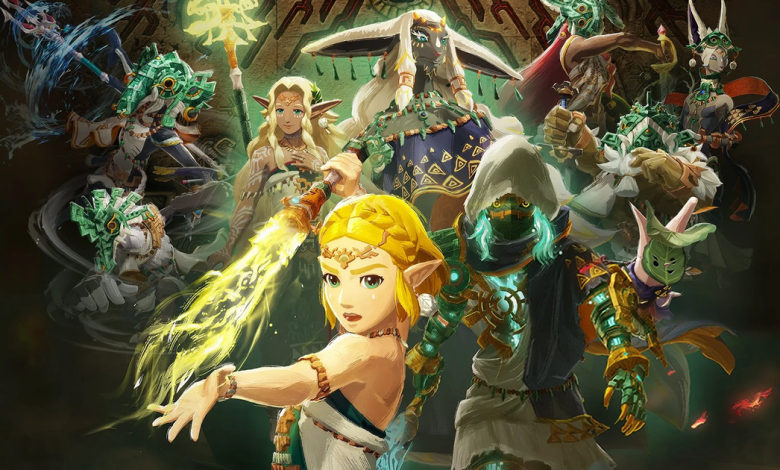Series-best combat carried me through Hyrule Warriors: Age of Imprisonment, but I think I’m done with the Breath of the Wild version of the Zelda universe

Chances are you already know what you’re getting with Hyrule Warriors: Age of Imprisonment. This is the third time we’ve seen The Legend of Zelda cross over with Koei Tecmo’s Warriors franchise, and truth be told the two partners have become remarkably good at making these games – which are by their very nature a rather known quantity.
Hyrule Warrios: Age of Imprisonment
- Developer: Koei Tecmo
- Publisher: Nintendo
- Platform: Played on Switch 2
- Availability: Out 6th November on Nintendo Switch 2
For my money, the first Hyrule Warriors was one of the most interesting takes on the one-versus-many Musou genre. It treated the Musou setup as a foundation, and then used the trappings and concepts of The Legend of Zelda as icing on that proven-tasty cake. That ended up to be a pretty convincing formula, with the Zelda trappings meshing better with Warriors than the likes of Fire Emblem or One Piece, ultimately serving to elevate the deliberately simplistic and junk foodian nature of the hack-and-slash battles.
Where the first game mashed up Zelda imagery from across the decades, 2020’s Hyrule Warriors: Age of Calamity continued on the same path but channeled the worldview of a single entry, Breath of the Wild, offering a non-canon alternative universe take on that game’s events. Now we have Hyrule Warriors: Age of Imprisonment, which itself offers a further twist – this time, rather than a curious alternate retelling of a game you already love, this latest Hyrule Warriors will fill gaps in Tears of the Kingdom’s backstory in a canonical manner.
That leaves the developers with quite a bit of room to manoeuvre. In Tears of the Kingdom, Zelda gets zapped back in time to ancient Hyrule while Link is stuck in the present. Over the course of that game you do indeed figure out the broad strokes of what happens in Zelda’s journey through the past – but much of ancient Hyrule is left to the imagination. Age of Imprisonment focuses on that, presenting a specific Zelda-led narrative covering a new version of ‘The Imprisoning War’, a formative event in the series legend.
Image credit: Nintendo
Your mileage with this will, I imagine, vary. A curious thing about the setup of Age of Imprisonment is that it heavily relies on your having become well invested in some of the supporting cast of Tears of the Kingdom. How interested you feel in the trials and tribulations of King Rauru, Queen Sonia, Mineru and the like – especially when we’ve already seen their story bought to completion in Tears of the Kingdom – is likely to heavily impact how much you enjoy this title’s narrative, and in turn how invested you feel.
You can probably sense from my tone that it didn’t work for me as much. Don’t get me wrong, it’s all fine, and is one of the most in-depth Hylian narratives ever presented. Probably the best thing about this is that it is Zelda’s story first and foremost – a real chance for that character to shine as a lead in a truly narrative-driven game. But the more I played the more that I realised that I think I’m ‘done’ with the Breath of the Wild version of the Zelda universe; I’m ready for the series to tackle pastures new, as it often does. I didn’t realise it when I played it, but what I’ve discovered is that Tears of the Kingdom was a perfectly fine coda to that version of Link, Zelda, and Hyrule for me.
The story intrigues most, I suppose, when it feels to be breaking with Zelda’s hands-off franchise tradition. Quite often you’re treated to a cinematic walk through a zone as characters chatter, for instance. Even as I write about it, I honestly can’t decide if this stuff feels cloying or as a nice counterpoint to the storytelling this series usually dabbles in. What I can say for sure is that these moments still feel strange – for this graphically looks so identical to Breath of the Wild and Tears of the Kingdom that, at a glance, these calmer in-gameplay story moments where you’re not slashing up hundreds of enemy troops give the glorious vibe of the world’s most expensive romhack.
With all that said, Age of Imprisonment does have an ace up its tunic sleeve – and that is the fact it’s the most expansive and satisfying Musou cross-over spin-off ever. This is the best one of these games has ever been, and as a result I found that it was the actual combat and gameplay propelling me through more than the story.
Watch on YouTube
Obviously this game is a direct spin-off from Tears of the Kingdom, and so much of its mechanical richness comes from a thoughtful interpretation and translation of that game’s systems into the Warriors format. Mechanical is the right word, since so much of this begins with the Zonai Devices, the mysterious ancient technology that is replete in Tears of the Kingdom’s world. Here Zonai devices can be equipped to your warrior of choice, adding both unique special moves and an elemental factor into combat. That means flamethrowers and gushing water hydrants abound, for instance. This sort of thing can be used not only to battle enemies directly but also to solve minor puzzles or engage in a bit of battlefield control.
Some of the Breath of the Wild and Tears of the Kingdom systems live on here in terms of how various elemental powers can interact with the world to impressive and useful effect. On top of all this some enemies have straight up elemental weaknesses, which means you’ll be thinking carefully not only about the selection of Warriors you bring into battle but also what Zonai Devices are equipped to which of your fighters. There’s an emphasis on the characters, too, with things like sync strike attacks where different pairings offer up a variety of outcomes in terms of the resulting attacks. Battery becomes another resource you must manage through the ebb and flow of a battle, too. Ultimately, it’s satisfying stuff that builds nicely on ideas from the previous title.
Many structural elements are meanwhile directly retained from Age of Calamity, such as the broad strokes of character progression, and a world map which is used to enter missions, purchase upgrades, and otherwise manage your progress. Where Age of Calamity broke things up with the spectacle of some battles where you pilot Divine Beasts, there’s a suitably showy replacement, which I don’t want to spoil beyond saying it’s a fun distraction that feels like it’s dropped out of a different genre.
As I say, this all feels like a build-up of systems that enhances what Warriors offers by default, and the end result is something more engaging and satisfying than other games of this type. It’s another one of these games – but as I say, it’s some of the best that the Musou-slash-Warriors genre-slash-series has seen.
Oh, and here’s a bonus: this is one of these games that runs well. I don’t associate Warriors with that, even on higher-end consoles. But this is great. I don’t know if it began life as a Switch 1 game and was then shifted to the successor machine or what, but whatever the reasoning I’m thrilled to note that this looks nice enough but also maintains a solid and high frame rate, even when hundreds of troops are bouncing around on screen.
I’ve always thought of Dynasty Warriors and its kin as the gaming equivalent of an extremely stupid popcorn action flick. You turn your brain off and turn a few thousand troops into bloodless mush. It’s satisfying. They’re easy to play, so they’re great for kids – or for hangovers. It’s this status that perhaps stops me from holding Age of Imprisonment too much to account for the fact my attention started to drift more or less every single time a cutscene began to play. In the end, that has never been what these games have been particularly good at, and grafting in the Zelda IP doesn’t really change that. It does open up a very welcome enriching of that iconic gameplay, though, and this is the richest offering yet.





